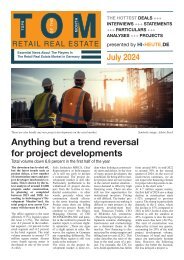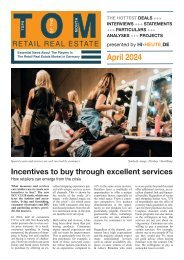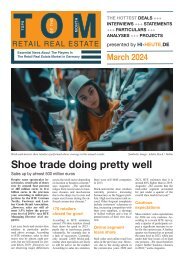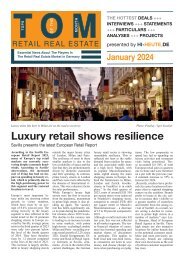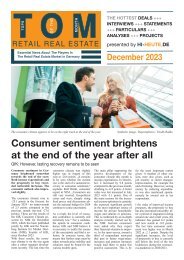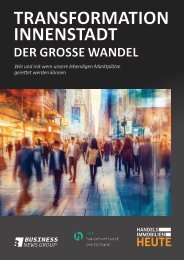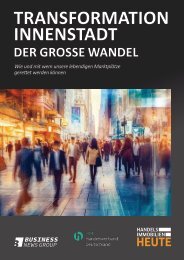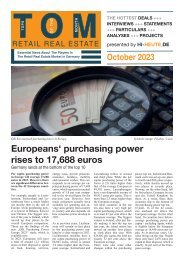TOM 02 2024
Create successful ePaper yourself
Turn your PDF publications into a flip-book with our unique Google optimized e-Paper software.
T<br />
TOPS<br />
M<br />
OF THE MONTH<br />
<strong>TOM</strong>O<br />
RETAIL REAL ESTATE<br />
TOPS<br />
OF THE<br />
MONTH<br />
Essential News About The Players In In<br />
The Retail Real Property Estate Market In in Germany<br />
THE HOTTEST DEALS +++<br />
INTERVIEWS +++ STATEMENTS<br />
+++ PARTICULARS +++<br />
ANALYSES +++ PROJECTS<br />
presented by HI-HEUTE.DE<br />
February 2<strong>02</strong>4<br />
According to the BTE, sales of clothing and textiles have risen to 67.4 billion euros. <br />
Symbolic image: Depositphotos/Artur Verkhovetskiy<br />
Clothing and textiles sector<br />
increases turnover<br />
Slightly above pre-corona level at 0.3 percent<br />
According to initial projections<br />
by BTE Handelsverband<br />
Textil Schuhe Lederwaren, retail<br />
sales of clothing and household<br />
and home textiles rose<br />
by around one percent or 650<br />
million euros to 67.4 billion<br />
euros including VAT last year.<br />
„However, with an increase of<br />
0.3%, sales are only slightly<br />
above the pre-corona level of<br />
2019,“ reports BTE Managing<br />
Director Axel Augustin. Brickand-mortar<br />
clothing retailers<br />
in particular performed above<br />
average last year. According<br />
to BTE estimates, sales at boutiques,<br />
fashion stores and textile<br />
chains rose by three to four<br />
percent, but are still around five<br />
percent below 2019.<br />
The opposite was true for specialist<br />
retailers of household<br />
and home textiles, which have<br />
seen a single-digit drop in sales<br />
since their boom phase during<br />
the pandemic. „We are also<br />
observing major differences<br />
across the retail sector depending<br />
on location or business<br />
concept,“ states Augustin. „The<br />
spectrum ranges from record<br />
sales to business closures or insolvencies<br />
due to the sharp rise<br />
in costs and major asset losses<br />
during the enforced coronavirus<br />
closures.“<br />
Mail order loses<br />
out<br />
Mail order and online retail lost<br />
sales last year. However, due to<br />
the strong upswing in the coronavirus<br />
years 2<strong>02</strong>0 and 2<strong>02</strong>1,<br />
BTE estimates that it is around<br />
30 percent higher than in 2019.<br />
Augustin: „We currently expect<br />
a market share of just under 28<br />
percent for the entire mail order<br />
business with clothing as well as<br />
household and home textiles.“<br />
Textile and fashion retailers‘<br />
sales expectations for 2<strong>02</strong>4 are<br />
very cautious. According to a<br />
recent BTE survey, only three<br />
out of ten participants expect a<br />
significant increase in sales for<br />
the current year.<br />
A third see themselves at around<br />
the same level as 2<strong>02</strong>3, while<br />
four out of ten fear losses of at<br />
least one percent. „If costs continue<br />
to rise and the state reclaims<br />
the bridging aid paid out,<br />
many retailers may soon have to<br />
close their businesses,“ warns<br />
Augustin.
Page 2<br />
URW with successful<br />
performance in Germany<br />
The letting strategy is also working in Austria<br />
Unibail-Rodamco-Westfield<br />
(URW) currently operates 21<br />
locations in the Germany and<br />
Austria region: 19 in Germany,<br />
eight of which are in the<br />
Group‘s own portfolio, and<br />
two in Austria. A total of 714<br />
rental agreements were concluded<br />
for these 21 locations<br />
last year.<br />
The average vacancy rate for<br />
the core locations in the portfolio<br />
around Westfield Centro in<br />
Oberhausen, Ruhr Park in Bochum,<br />
Westfield Shopping City<br />
Süd in Vösendorf in the greater<br />
Vienna area and Westfield Donau<br />
Zentrum in Vienna is less<br />
than two percent.<br />
Management on<br />
course for growth<br />
In addition, the mixed-use project<br />
Westfield Hamburg-Überseequartier,<br />
which URW is<br />
developing in Hamburg‘s HafenCity<br />
and which will open on<br />
April 25, has also seen a lot of<br />
progress. The occupancy rate<br />
for the retail, gastronomy and<br />
leisure sectors is now a good<br />
90 percent. The letting strategy<br />
established by the company<br />
years ago is proving its worth,<br />
particularly in the current market<br />
situation.<br />
The URW Real Estate Management<br />
division, which bundles<br />
the management of retail properties<br />
for investor partners on<br />
the German market, continues<br />
to grow. In 2<strong>02</strong>3, the management<br />
contracts for the WIL-<br />
MA (owned by Ivanhoé Cambridge)<br />
and Gropius Passagen<br />
NEWS<br />
Preparations for the Boda Borg Questing concept are underway at<br />
Ruhr Park in Bochum - open-ing in spring.<br />
<br />
Photo: Daniel Schäfer / URW<br />
(Nuveen/URW) locations in<br />
Berlin, the Düsseldorf Arcaden<br />
(Hines) and the Köln Arcaden,<br />
Spandau Arcaden in Berlin and<br />
Riem Arcaden in Munich (Union<br />
Investment) were extended<br />
on a long-term basis. The division<br />
accounts for almost half<br />
of the rental space and rental<br />
agreements in URW‘s German<br />
portfolio and is aiming for consistent<br />
growth in both Germany<br />
and Austria.<br />
February 2<strong>02</strong>4<br />
Intersport International<br />
sets record result in<br />
2<strong>02</strong>3<br />
Intersport International Corporation<br />
(IIC), the international umbrella<br />
organization of the national<br />
Intersport associations based<br />
in Switzerland, closed the year<br />
2<strong>02</strong>3 with global retail sales of<br />
13.7 billion euros. Although this<br />
did not represent growth, it was<br />
exactly the same record result as<br />
the previous year, the association<br />
emphasizes, pointing to the<br />
generally challenging business<br />
environment in the sports retail<br />
sector. While 2<strong>02</strong>3 started with a<br />
strong first quarter, the combination<br />
of the difficult economic and<br />
geopolitical climate, ongoing<br />
challenges in the supply chain,<br />
high inventory levels and rising<br />
operating costs weakened the<br />
economy in sports retail.<br />
Pepco ceases<br />
business operations<br />
in Austria<br />
After just over two years, the<br />
retail group Pepco Group NV<br />
is discontinuing its business activities<br />
in Austria. The group,<br />
which is active in Austria with<br />
73 locations of the discounter of<br />
the same name, has come to the<br />
conclusion after an ongoing and<br />
thorough performance review<br />
that this market does not meet<br />
expectations, the Pepco Group<br />
announced at the end of february.<br />
Mall of Berlin welcomes several new tenants<br />
HGHI occupies space from fashion to gastronomy<br />
New tenants enrich the Mall<br />
of Berlin. Most recently,<br />
HGHI Holding GmbH welcomed<br />
Colloseum Fashion.<br />
The label opened a 450 square<br />
meter store in the shopping<br />
center at Leipziger Platz in February.<br />
Colloseum Fashion is a<br />
German fashion brand that specializes<br />
in trendy and affordable<br />
looks for young women. In addition<br />
to Germany, the company<br />
now also has stores in other<br />
European countries. Colloseum<br />
Fashion‘s trademark is a mix of<br />
casual street style and feminine<br />
elements. The collections include<br />
clothing, shoes and accessories<br />
for various occasions, from<br />
casual outfits to more chic pieces<br />
for special occasions.<br />
The CNICK goods label was<br />
also added in February. The<br />
company presented the very first<br />
smart ring made of precious metal,<br />
which enables contactless<br />
payment and can be used as a<br />
car key. Subway made its debut<br />
in the Mall of Berlin at the end<br />
of 2<strong>02</strong>3 with customized sandwiches,<br />
salads and wraps. The<br />
branch is located in the food<br />
court on the second floor.<br />
New tenants have recently enriched the Mall of Berlin.<br />
<br />
Photo: Pixabay / Piet van de Weil<br />
In the immediate vicinity of<br />
sights such as the Brandenburg<br />
Gate, Reichstag and Holocaust<br />
Memorial, the Mall of Berlin<br />
offers an urban mix of shopping,<br />
restaurants, hotels, entertainment,<br />
offices and living.<br />
The shopping and experience<br />
center, which opened in 2014 on<br />
the former site of the Wertheim<br />
department store, comprises a<br />
total of around 76,000 square<br />
meters of retail space, around<br />
12,000 square meters of hotel<br />
space and 30,000 square meters<br />
of residential space. With more<br />
than 300 stores, one of the largest<br />
food courts in Germany and<br />
an extensive event program, the<br />
Mall of Berlin attracts around<br />
22 million visitors from Germany<br />
and abroad every year.
Page 3<br />
TOP STATEMENT OF THE MONTH February 2<strong>02</strong>4<br />
TOP STATEMENT<br />
February<br />
„Top shopping centers<br />
are attractively priced<br />
on the capital market<br />
today, especially compared<br />
to other real<br />
estate assets such as<br />
office, residential or<br />
logistics. They have<br />
not experienced the<br />
interest-driven boom<br />
of recent years, which<br />
is why no corresponding<br />
corrections are<br />
pending here.“<br />
Volker Kraft, Managing Director<br />
of ECE Real Estate, in a<br />
statement for the German trade<br />
publication „Immobilien Zeitung“
Integrated approach<br />
to real estate<br />
We find solid platforms from which we can create sound investments, all around the<br />
world. From shopping to public or living spaces, from management to turnkey projects,<br />
we are the most far-sighted partner when developing innovative concepts.<br />
www.sonaesierra.com
Page 5 ANALYSES February 2<strong>02</strong>4<br />
Hope for an upturn in retail investments<br />
After a weak year, conditions are improving according to CBRE<br />
In 2<strong>02</strong>3, the German retail<br />
real estate investment market<br />
recorded a transaction volume<br />
of 5.4 billion euros. Compared<br />
to 2<strong>02</strong>2, this is a decrease<br />
of 43%. The top seven<br />
cities accounted for 33% of<br />
the transaction volume, eight<br />
percentage points more than<br />
in 2<strong>02</strong>2, according to a re-cent<br />
analysis by CBRE.<br />
„While the retail sector remained<br />
stable in 2<strong>02</strong>3 despite the<br />
mild recession, the general restraint<br />
on the real estate investment<br />
market was also reflected<br />
in retail properties,“ says Jan<br />
Schönherr, Head of Retail Investment<br />
at CBRE in Germany.<br />
„In particular, the sharp rise in<br />
fi-nancing costs and yields on<br />
alternative investments slowed<br />
the German real estate investment<br />
market from its usual high<br />
momentum last year,“ explains<br />
Dr. Jan Linsin, Head of Research<br />
at CBRE in Germany.<br />
The recent decline in financing<br />
interest rates and more moderate<br />
yields on fixed-interest securities<br />
provide more planning<br />
security and make real estate<br />
investments more attractive.<br />
Local suppliers<br />
top again<br />
Once again, properties in the<br />
retail and food market segment,<br />
including convenience stores<br />
and retail parks, accounted for<br />
the largest share of transactions.<br />
They accounted for 59% of the<br />
transaction volume - eleven<br />
percentage points more than in<br />
2<strong>02</strong>2. This means that these retail<br />
property types are as popular<br />
with investors as they were in<br />
2<strong>02</strong>1, when they reached a peak<br />
of 60%. One-A retail properties<br />
were also able to increase their<br />
share. The acquisition of shares<br />
in various trophy properties<br />
such as KaDeWe, the MYND &<br />
Galeria Weltstadthaus ensemble<br />
and eight Signa Prime Selection<br />
department stores contributed to<br />
this high share. Shopping centers,<br />
on the other hand, played<br />
virtually no role in 2<strong>02</strong>3. Their<br />
share of the already declining<br />
transac-tion volume amounted<br />
to just under five percent. In the<br />
previous year, this figure was<br />
still 29% due to various special<br />
effects as well as individual<br />
According to the BTE, sales of clothing and textiles have risen to 67.4 billion euros.<br />
<br />
Symbolic image: Depositphotos / Artur Verkhovetskiy<br />
lighthouse transactions. „While<br />
there was hardly any momentum<br />
in the shopping center market<br />
in 2<strong>02</strong>3, we expect to see<br />
significantly greater movement<br />
in the transaction market for<br />
shopping centers in 2<strong>02</strong>4,“ says<br />
Schönherr.<br />
In 2<strong>02</strong>3, international investors<br />
were able to significantly increase<br />
their share of the transaction<br />
market by 22 percentage points<br />
to 53%. This underlines the fact<br />
that investors from abroad in<br />
particular are convinced of the<br />
resilient fundamentals of the<br />
German economy and its real<br />
es-tate sector. „We assume that<br />
international interest in German<br />
retail real estate will continue in<br />
2<strong>02</strong>4. This is because the retail<br />
sector already showed great stability<br />
in 2<strong>02</strong>3, the growth of online<br />
retail has slowed and yields<br />
have become more attractive<br />
again for international investors,“<br />
says Schönherr.<br />
Yields have<br />
increased<br />
„Net acquisition yields for retail<br />
properties increased in all segments<br />
in 2<strong>02</strong>3, in line with the<br />
other real estate asset classes,“<br />
explains Anne Gimpel, Team<br />
Leader Valuation Advisory Services<br />
at CBRE in Germany. The<br />
prime yield for single-A retail<br />
properties in the top seven cities<br />
averaged 4.84% at the end<br />
of 2<strong>02</strong>3. Compared to the end of<br />
2<strong>02</strong>2, this represents an increase<br />
of 0.95 percentage points. 0.3<br />
percentage points were attributable<br />
to the fourth quarter of<br />
2<strong>02</strong>3.<br />
More momentum<br />
expected<br />
In comparison, the prime yields<br />
of shopping centers in A and B<br />
locations rose slightly mo-re<br />
strongly in the last quarter: by<br />
0.4 and 0.35 percentage points<br />
to 5.9% and 7.2% respectively.<br />
Over 2<strong>02</strong>3 as a whole, the values<br />
therefore rose by 0.8 and<br />
0.7 percentage points respectively.<br />
Neither grocery stores nor<br />
retail parks recorded an increase<br />
in prime yields in the second<br />
half of 2<strong>02</strong>3. Over the course<br />
of the year as a whole, however,<br />
the prime yield of food markets<br />
rose by 0.4 percentage points<br />
to 4.7% and that of retail parks<br />
by 0.7 percentage points to 5%.<br />
Never-theless, there are signs of<br />
stabilization here and in the net<br />
initial yields for first-class DIY<br />
stores, which rose by one percentage<br />
point over the year to<br />
currently 5.75%.<br />
According to CBRE, 2<strong>02</strong>4 can<br />
be expected to get off to a rather<br />
subdued start at the beginning<br />
of the year, with transaction<br />
activity gaining momentum as<br />
the year progresses. Investors<br />
acti-ve in the retail sector will<br />
be offered attractive investment<br />
opportunities in all risk structures<br />
and sub-asset classes over<br />
the year as a whole, Schönherr<br />
expects.<br />
„It is currently difficult to predict<br />
what volume the investment<br />
market for retail properties will<br />
achieve for the year as a whole.<br />
This is because it largely depends<br />
on the success of refinancing<br />
and the extent to which and<br />
when national institutional investors<br />
will significantly increase<br />
their willingness to invest<br />
again.“ „The ECB‘s tightening<br />
of monetary policy is increasingly<br />
taking effect, meaning<br />
that the cycle of interest rate hikes<br />
could have reached a peak<br />
and provide more planning certainty<br />
for investment decisions.<br />
In contrast to many other market<br />
participants, however, we<br />
warn against assuming that key<br />
interest rates will be cut soon,<br />
as the ECB continues to sound<br />
cautious - it seems convinced<br />
of the persistence of inflation,“<br />
Linsin points out. „Against the<br />
backdrop of further stabilization<br />
in financing conditions, real estate<br />
yields should have largely<br />
left their up-ward trend behind<br />
them by 2<strong>02</strong>4,“ predicts Gimpel.
URBAN CREATORS.<br />
Architecture | Development & Project Management<br />
European Council of Shopping Places (ECSP) Awards: Commendation for Best Renovation/Expansion for centres between 15.000 – 45.000 sqm
Page 7 RETAIL February 2<strong>02</strong>4<br />
The furniture industry is currently struggling with declining sales. <br />
Symbolic image: Unsplash / Michelle Williams<br />
Challenging times<br />
for the furniture industry<br />
IFH and BBE predict another difficult year<br />
Market saturation, shift in<br />
spending and rising prices:<br />
The general conditions were<br />
very challenging for the furniture<br />
industry in 2<strong>02</strong>3. After<br />
a good year in 2<strong>02</strong>2 with sales<br />
growth of almost ten percent,<br />
the industry lost 3.6 percent in<br />
2<strong>02</strong>3 - despite significant price<br />
increases - and thus stands at<br />
22.6 billion euros.<br />
The reason for the slump: the<br />
shift in consumer spending due<br />
to the continuing very high<br />
energy prices and cost of living.<br />
In addition, furniture is becoming<br />
increasingly expensive<br />
due to higher production costs<br />
for raw materials, energy and<br />
transportation. An average piece<br />
of furniture costs around 20<br />
percent more today than it did in<br />
2<strong>02</strong>0. These and other findings<br />
are contained in the new „Furniture<br />
Sector Report“ published<br />
by IFH COLOGNE and BBE<br />
Handelsberatung. The market<br />
experts are forecasting another<br />
challenging year for 2<strong>02</strong>4 with<br />
a negative sales trend.<br />
Significant decline<br />
in sales<br />
„With the significant decline in<br />
sales in 2<strong>02</strong>3 and simultaneous<br />
price increases, the furniture<br />
trade is currently under pressure.<br />
The aim is to compensate<br />
for productivity losses by optimizing<br />
sales performance or<br />
reducing space and to secure<br />
important contribution margins<br />
through these frequency-promoting<br />
alternative offers,“ says<br />
Dr Philipp Hoog, Member of<br />
the Management Board & Head<br />
of Strategy Consulting BBE<br />
Handelsberatung, assessing the<br />
data.<br />
Large chain stores still account<br />
for the largest share of the furniture<br />
retail market volume<br />
(38.0%), followed by specialist<br />
furniture retailers (27.9%).<br />
Both have expanded their online<br />
activities since the pandemic<br />
and have thus slowed down the<br />
growth of pure mail order companies<br />
and internet pure players.<br />
Specialist retailers are holding<br />
their own like in hardly any other<br />
market.<br />
Stationary retailers<br />
score points online<br />
Due to the successful online<br />
activities of brick-and-mortar<br />
retailers, the online share of<br />
the furniture market increased<br />
in 2<strong>02</strong>3 - despite the decline in<br />
sales in the industry as a whole -<br />
and now stands at 13.7%.<br />
The outlook for further market<br />
development in 2<strong>02</strong>4 and 2<strong>02</strong>5<br />
remains cautious. The negative<br />
economic outlook will also affect<br />
the furniture trade.<br />
Market growth in<br />
2<strong>02</strong>6 at the earliest<br />
The market experts from IFH<br />
KÖLN and BBE Handelsberatung<br />
anticipate a further nominal<br />
decline in sales of -2.6%<br />
in the medium forecast variant.<br />
Slight market growth is not<br />
expected until 2<strong>02</strong>6. „Private<br />
households are unsettled and<br />
are in savings mode. Spending<br />
on furniture is being postponed<br />
or people are turning to secondhand<br />
goods. This trend will continue<br />
in 2<strong>02</strong>4. To make matters<br />
worse, the construction industry<br />
has also been hit by the crisis.<br />
However, inflation is calming<br />
down and there is light on the<br />
horizon,“ says Christoph Lamsfuß,<br />
Senior Consultant at IFH<br />
COLOGNE.
Page 8 INTERVIEW February 2<strong>02</strong>4<br />
„Formerly a future location,<br />
now a future location!“<br />
The huge „Behrensufer Berlin“ project: Interview with CEO Robert Sparjcar<br />
Deutsche Immobilien Entwicklungs<br />
AG (DIEAG) is<br />
planning BE-U, an innovative<br />
model district for industry, on<br />
the ten-hectare site on Behrens-Ufer,<br />
which is located<br />
in Berlin‘s south-east boom<br />
corridor in the triangle formed<br />
by BER Airport, Tesla<br />
and Berlin Mitte. Around<br />
12,000 people are expected<br />
to work there in future, primarily<br />
in the life sciences,<br />
laboratory and light industry<br />
sectors. Innovative spaces for<br />
retail, events and gastronomy<br />
are also part of the plans.<br />
At the end of October, DIE-<br />
AG celebrated the symbolic<br />
ground-breaking ceremony<br />
and project launch at BE-U.<br />
In the <strong>TOM</strong>-interview Robert<br />
Sprajcar, CEO of DIEAG,<br />
provides details on the vision<br />
and development of the Berlin<br />
lighthouse project.<br />
<strong>TOM</strong>: Mr Sprajcar, you are<br />
responsible for a billion-euro<br />
project on Behrens-Ufer in<br />
the south-east of Berlin with<br />
a wide variety of realizations.<br />
How did the idea come about<br />
and what is the vision behind<br />
it?<br />
Robert Sprajcar: We were<br />
inspired by the history of the<br />
site. In 1895, the world‘s first<br />
three-phase power station laid<br />
the foundations not only for<br />
the electrification of Berlin, but<br />
also for the establishment of innovative<br />
production companies.<br />
Over 100 years ago, the entire<br />
Oberschöneweide industrial<br />
belt in south-east Berlin was already<br />
ahead of the curve. Back<br />
then a future location, today a<br />
future location. The progressive<br />
ideas of merging functionality<br />
and aesthetics, productivity and<br />
social issues, as advocated by<br />
the Werkbund at the beginning<br />
of the 20th century, are still reflected<br />
today in the unique industrial<br />
architecture of the site<br />
by Peter Behrens. We are building<br />
on this and thinking about<br />
neighborhood design from the<br />
perspective of the users, i.e. the<br />
people. This inevitably results<br />
Robert Sprajcar, CEO of DIEAG <br />
in usage and socially relevant<br />
development directions that ensure<br />
that Behrens-Ufer is developed,<br />
converted and expanded<br />
as a future-proof urban technology<br />
quarter. Our vision is therefore<br />
also to build nothing less<br />
than one of the world‘s most<br />
sustainable commercial districts,<br />
where people are at the<br />
center.<br />
<strong>TOM</strong>: How big is your team<br />
at the moment, and from<br />
which areas of work is it recruited?<br />
Robert Sprajcar: Our core<br />
team within DIEAG consists of<br />
around 20 people, all of whom<br />
come from a wide range of disciplines,<br />
including civil engineering,<br />
architecture, urban<br />
development, communication,<br />
politics, energy, vertical farming,<br />
art and culture as well as<br />
social science research. We also<br />
need this professional diversity<br />
in order to guarantee the implementation<br />
of our vision. Furthermore,<br />
we naturally have experienced<br />
partners in planning,<br />
construction and project development<br />
as well as competent<br />
contacts in the authorities and<br />
in civil society, without whose<br />
constructive contribution such a<br />
project would not work.<br />
<strong>TOM</strong>: What do you think is<br />
exceptional about this project?<br />
Robert Sprajcar: The holistic<br />
nature of the project development<br />
approach and our vision<br />
Photo: DIEAG<br />
are what make it exceptional.<br />
The vision is based on the<br />
exemplary combination of various<br />
elements from urban planning,<br />
business, science, art and<br />
culture, including community<br />
building for the participatory<br />
further development of the district,<br />
which is of course already<br />
having an impact on the project<br />
development in the early<br />
implementation phase. Finally,<br />
the sheer scale of the project<br />
as a complete neighborhood<br />
development also enables us to<br />
synergistically interlink individual<br />
technical systems to create<br />
holistic cycles, e.g. in sustainable<br />
energy supply, cycle management<br />
and neighborhood<br />
logistics.<br />
<strong>TOM</strong>: What about the imple-
Page 9 INTERVIEW February 2<strong>02</strong>4<br />
Huge: The innovative model district for a wide variety of businesses will cover around ten hectares.<br />
<br />
Visualization: Peter Rüssmann & DIEfabrik GmbH for DIEAG<br />
mentation of the envisaged<br />
retail and restaurant space?<br />
Robert Sprajcar: We are planning<br />
a total of 20,000 square<br />
meters for event, retail and<br />
gastronomy uses. A maximum<br />
of 3,000 sqm of retail space is<br />
planned, primarily with sustainable<br />
local suppliers and service<br />
providers. Concrete usage<br />
approaches are in place and<br />
corresponding tenants are already<br />
in the expansion planning<br />
stage. As consumer behaviour<br />
has changed due to the coronavirus<br />
pandemic and digitalization,<br />
flexible office and multifunctional<br />
retail concepts are<br />
planned.<br />
We have also set up so-called<br />
„innovation LABs“ as dedicated<br />
working groups with the<br />
participation of various experts<br />
to network the BE-U-specific<br />
requirements with innovative<br />
approaches from science,<br />
business, politics, administration<br />
and civil society. These<br />
LABs work on the four key<br />
neighbourhood-related topics,<br />
namely „urban development“,<br />
„new energy“, „food“ and „arts<br />
& culture“.<br />
The urban development LAB<br />
focuses on pressing, futureoriented<br />
topics and trends in<br />
urban development, such as urban<br />
transformation, sustainable<br />
mobility, quality of life in urban<br />
areas and civil society participation<br />
in the project. The LAB<br />
develops concrete best practices<br />
and innovative solutions directly<br />
in our neighborhood.<br />
The new energy LAB involves<br />
experts from the European Parliament,<br />
the Berlin Senate and<br />
companies that have been recruited<br />
for the implementation<br />
of the sustainable energy concept<br />
and, in particular, inner-city<br />
deep geothermal energy. For<br />
the food LAB, successful Berlin<br />
restaurateurs and developers<br />
from the field of vertical farming<br />
are working together on a<br />
completely new, unique gastronomy<br />
and supply concept.<br />
Last but not least, there is the<br />
arts & culture LAB. In our view,<br />
art and culture are key elements<br />
for the development of a vibrant<br />
and diverse location, and<br />
the events and concerts of the<br />
LAB at BE-U are already being<br />
enthusiastically received by a<br />
diverse audience.<br />
<strong>TOM</strong>: Nowadays, the sustainability/ESG<br />
aspect plays a<br />
central role in such construction<br />
projects. How are you doing<br />
justice to this at Behrens-<br />
Ufer?<br />
Robert Sprajcar: Our aim is<br />
to create one of the most sustainable<br />
neighborhoods in the<br />
world. We have based our project<br />
development approach on<br />
ESG principles from the outset,<br />
but we go far beyond the usual<br />
standards. The usual sustainability<br />
certifications are therefore<br />
merely a windfall.<br />
We combine sustainabilityoriented<br />
approaches to building<br />
physics and energy technology<br />
with questions of use in<br />
both the productive and social<br />
sense and thus create an urban<br />
quarter that is completely selfsufficient<br />
in electricity, heating<br />
and cooling from renewable<br />
energy sources and offers the<br />
highest quality of stay in the<br />
entirely public outdoor area,<br />
taking advantage of the natural<br />
conditions on site (south-facing<br />
orientation of the site, waterfront<br />
location, district-related<br />
economies of scale and synergy<br />
effects, etc.).<br />
We are building on existing<br />
buildings and creating a model<br />
district for the „smart city of<br />
tomorrow“ with an urban mix<br />
of uses - albeit without housing<br />
- and short distances, a districtwide<br />
integrated circular economy,<br />
rainwater management and<br />
much more.<br />
<strong>TOM</strong>: When do you plan to<br />
complete it? What are your<br />
most difficult tasks and biggest<br />
challenges along the<br />
way?<br />
Robert Sprajcar: Due to the<br />
coronavirus, we expect to be<br />
finished at the beginning of<br />
2<strong>02</strong>9. The biggest challenges<br />
up to this point have been the<br />
urban planning concept, which<br />
we developed together with the<br />
Treptow-Köpenick district office,<br />
as well as the monument<br />
protection concept, which was<br />
developed with the Berlin State<br />
Monument Office and the Lower<br />
Monument Authority. In<br />
particular, the integration of the<br />
new construction projects into<br />
the listed existing environment<br />
was challenging, complex and<br />
not trivial.<br />
The comprehensive new planning<br />
of the transport connections<br />
and infrastructure is also<br />
of central importance: we are<br />
planning ferry connections on<br />
the Spree in order to get to the<br />
Berlin S-Bahn network on the<br />
other side of the river more quickly.<br />
The possibility of building a<br />
bridge over the Spree in cooperation<br />
with the city of Berlin is<br />
also currently being examined.
The art of<br />
investing<br />
Tailor-made investments in German supermarkets<br />
As real estate experts, we invest in grocery stores<br />
and retail parks throughout Germany.<br />
The advantage?<br />
Financially very strong tenants and crisis-proof basic<br />
supply ensure sustainable attractive returns for<br />
investors.<br />
20 years of experience in food retail<br />
Excellent network<br />
Working in partnership<br />
Big plans? So do we.<br />
Talk to us:<br />
Jörn Burghardt • Managing Director<br />
Phone: +49 (69) 756694334 • E-mail: j.burghardt@g-pep.com<br />
GPEP GmbH · Hamburger Allee 26-28 · 60486 Frankfurt/Main GERMANY • www.g-pep.com
Page 11 NEWS February 2<strong>02</strong>4<br />
Tackle with a sense of proportion!<br />
Interview with Barbara Possinke, Senior Partner at RKW Architektur + (Düsseldorf)<br />
Major insolvencies in the<br />
retail segment are making<br />
headlines, construction costs<br />
remain at a high level, and<br />
then there is climate change,<br />
which is pushing for change.<br />
How can a transformation of<br />
our city centers succeed under<br />
these conditions? In an interview<br />
with <strong>TOM</strong>, Barbara Possinke,<br />
Senior Partner at RKW<br />
Architektur +, pleads for decisive<br />
- but well-considered -<br />
action.<br />
<strong>TOM</strong>: Ms Possinke, you practically<br />
grew up building department<br />
stores. What do you<br />
see in your mind‘s eye when<br />
you hear the words „Galeria“<br />
or „KaDeWe“?<br />
Barbara Possinke: Of course,<br />
I continue to see the end of an<br />
era that now seems to have reached<br />
the premium segment. But<br />
at the same time, I also see great<br />
opportunities. The most important<br />
thing is to take a very differentiated<br />
approach and look at<br />
each location and each property<br />
very precisely and individually<br />
- and not just in terms of visitor<br />
flows and footfall figures. Then<br />
we will see that retail can continue<br />
to be worthwhile in some<br />
A-locations, but perhaps not in<br />
others. We must not have blinkers<br />
on here.<br />
<strong>TOM</strong>: What does that mean<br />
for city centers then?<br />
Barbara Possinke: As urban<br />
planners, we have been observing<br />
developments towards the<br />
„15-minute city“ for some time<br />
now. This can lead to a partial<br />
decentralization in large cities,<br />
which leads away from the classic<br />
„one city centre concepts“<br />
and strengthens individual district<br />
cores for daily supply. But<br />
this does not mean the end of<br />
the city center!<br />
<strong>TOM</strong>: Why not?<br />
Barbara Possinke: I think we<br />
have to look at it this way: because<br />
we are not losing supply<br />
there, but gaining space - space<br />
for quality. If the supply shifts,<br />
we can reduce individual traffic<br />
there. This can create urban<br />
spaces with a high quality of<br />
stay - more green and open<br />
spaces, more restaurants, more<br />
Barbara Possinke, Senior Partner at RKW Architecture + Photo:<br />
Sakotic-Sondermann (RKW)<br />
places to see and be seen. After<br />
all, these are the very factors -<br />
alongside high-quality shopping<br />
facilities - that score particularly<br />
well in surveys when it comes to<br />
the attractiveness of city centers.<br />
<strong>TOM</strong>: This would also provide<br />
a spatial opportunity to<br />
better arm city centers against<br />
climate change ...<br />
Barbara Possinke: That‘s<br />
right. This is the next big problem,<br />
which is already showing<br />
up in bright red on the heat<br />
maps of many cities and which<br />
urgently needs to be tackled. I<br />
don‘t want to be alarmist here,<br />
but it won‘t be long before we<br />
can measure summer temperatures<br />
of over 50° C in the highly<br />
sealed, unshaded concrete landscapes<br />
of many pedestrian zones.<br />
This would make city centers<br />
uninhabitable - and needs to<br />
be repaired and adapted today.<br />
And by „today“ I mean now.<br />
<strong>TOM</strong>: What should we be doing?<br />
Barbara Possinke: We urgently<br />
need to unseal areas on a large<br />
scale. We need to manage water<br />
better - and this also applies to<br />
heavy rainfall events and the<br />
much-cited sponge city - and<br />
we need to manage the local<br />
climate. This means, for example,<br />
planning windbreaks wisely<br />
and providing much more and<br />
appropriate greenery. That way,<br />
even in 20 or 30 years‘ time, it<br />
will still be pleasant to spend<br />
time in the city center in midsummer.<br />
<strong>TOM</strong>: But what will become<br />
of the department stores?<br />
Barbara Possinke: As I said,<br />
I don‘t want to generalize. But<br />
I think demolition would be<br />
counterproductive in almost<br />
every case - for many reasons.<br />
As planners with strong retail<br />
know-how and urban planning<br />
expertise, we would always start<br />
by investigating whether another<br />
retail use might be possible<br />
after all, perhaps with a different<br />
concept or a mix of uses.<br />
Or another revitalization: department<br />
stores in particular,<br />
with their large spans and load-bearing<br />
ceilings, can be repurposed<br />
in so many different<br />
ways. Schools, laboratories or<br />
libraries could move in, often<br />
all that is needed are a few atriums.<br />
Of course, I also see the<br />
question of economic efficiency.<br />
But here I would see a task for<br />
the local authorities, the legislators,<br />
who can provide support<br />
through tax relief.<br />
<strong>TOM</strong>: Or demolish and rebuild?<br />
Barbara Possinke: Well, even<br />
if everything else turns out to<br />
be unrealistic, demolition is the<br />
worst alternative from a resource<br />
perspective alone. On the one<br />
hand, it‘s about the gray energy<br />
stored in the building, but on the<br />
other hand it‘s also about social<br />
sustainability - we need to<br />
get out of the growth spiral that<br />
has us building more and more,<br />
even though so much has already<br />
been built!<br />
<strong>TOM</strong>: Can we still manage<br />
to have liveable city centers -<br />
with attractive retail?<br />
Barbara Possinke: I think<br />
that‘s not only desirable, but<br />
also possible. In my vision, we<br />
have the space for it because we<br />
are drastically reducing rigid<br />
automotive infrastructures with<br />
their sealed surfaces in favor of<br />
significantly improved public<br />
transport, more cycle paths and<br />
hubs for e-mobility. Because we<br />
are letting cities breathe again,<br />
with green spaces and inviting<br />
restaurants and a good, varied<br />
range of retail options tailored<br />
to people‘s needs. Whether<br />
this takes place in department<br />
stores, former department stores<br />
or completely different formats<br />
must be decided on a case-bycase<br />
basis. The main thing is<br />
that we do it with a sense of proportion.<br />
<strong>TOM</strong>: And who should drive<br />
this transformation forward?<br />
Barbara Possinke: That‘s a<br />
very important point: no one can<br />
solve such a huge task on their<br />
own. We need large groups of<br />
experts to think about all layers<br />
of a city - from underground to<br />
the rooftops. Or also: from the<br />
subway and the pipeline construction<br />
to the first floor level<br />
with all the uses and public<br />
spaces right up to the top floors.<br />
In addition, we must not only<br />
think vertically, but also horizontally<br />
beyond the city center,<br />
for example by consolidating<br />
secondary locations and main<br />
locations. And one last thing:<br />
it takes time, it takes pragmatic<br />
solutions without blinkers, and<br />
it can only work together. So,<br />
let‘s get to work!
Increase visibility, reduce risk<br />
& enable team collaboration<br />
within a single connected<br />
solution<br />
OPTIMISE RETAIL REVENUE<br />
Yardi Elevate is designed for asset managers, leasing executives & operational<br />
managers for all types of commercial real estate to enhance performance<br />
• Drive new deals and enhance revenue<br />
• Work with detailed lease and financial data in<br />
real time<br />
• Streamline forecasting & model scenarios<br />
• Reduce friction & centralise team collaboration<br />
• Minimise risk & increase value<br />
+49 (0) 6131 14076 3<br />
Learn with us at yardi.de/products/elevate<br />
Get<br />
the<br />
details<br />
©2<strong>02</strong>2 Yardi Systems, Inc. All Rights Reserved. Yardi, the Yardi logo, and all Yardi product names are trademarks of Yardi Systems, Inc.
Page 13 ANALYSES February 2<strong>02</strong>4<br />
Hahn Group draws<br />
positive annual balance sheet<br />
Occupancy rate increased and funds secured<br />
The Hahn Group can look<br />
back on a successful 2<strong>02</strong>3 financial<br />
year. As an asset and<br />
investment manager, it achieved<br />
stable asset growth in its<br />
fund portfolios for the benefit<br />
of its investors. The performance<br />
of the Hahn real estate<br />
funds benefited from strategic<br />
sales, new lettings and numerous<br />
rent increases.<br />
CEO Thomas Kuhlmann explains:<br />
„The asset class of supply-oriented<br />
retail and mixeduse<br />
properties once again<br />
demonstrated its great resilience,<br />
value stability and earnings<br />
power in 2<strong>02</strong>3. Despite the challenging<br />
market environment,<br />
we were able to increase rental<br />
income across the entire portfolio<br />
by around three percent on a<br />
like-for-like basis and realized<br />
additional income opportunities<br />
for some funds through property<br />
sales. The performance was<br />
correspondingly positive: in the<br />
private client business, around<br />
30% of Hahn real estate funds<br />
increased their distributions<br />
compared to the previous year.<br />
There were no declines in distributions.“<br />
Two new retail<br />
funds<br />
In new business with private<br />
investors, two new retail AIFs<br />
were successfully launched in<br />
2<strong>02</strong>3: Pluswertfonds 178 and<br />
Pluswertfonds 180 invest in a<br />
local shopping center in Voerde<br />
in North Rhine-Westphalia and<br />
a retail park in Landshut, Bavaria.<br />
Both real estate funds have<br />
been very well received by customers.<br />
Pluswertfonds 178 has<br />
already been fully placed, and<br />
Pluswertfonds 180, which was<br />
only launched in December, is<br />
expected to be fully marketed<br />
by the end of the first quarter of<br />
2<strong>02</strong>4. The equity raised in 2<strong>02</strong>3<br />
amounted to a total of around 20<br />
million euros. The transaction<br />
volume in the private client and<br />
institutional business amounted<br />
to around EUR 216 million<br />
(previous year: EUR 516 million).<br />
Thomas Kuhlmann, CEO of the Hahn Group. Photo: Hahn Group<br />
In the past two years, the Hahn<br />
Group has increasingly realized<br />
gains on sales for its clients<br />
with its active management approach.<br />
In 2<strong>02</strong>2 and 2<strong>02</strong>3, real<br />
estate properties with a total<br />
volume of around 630 million<br />
euros were sold to third parties.<br />
The gains on sales were significantly<br />
higher than the purchase<br />
prices. With its core-plus<br />
investment approach, the Hahn<br />
Group‘s first institutional real<br />
estate fund, launched in 2008,<br />
generated an average annual<br />
return (IRR) of over seven percent<br />
for investors over a term<br />
of around 15 years. Thanks to a<br />
letting performance of 108,000<br />
square meters (previous year:<br />
226,000 square meters), the<br />
occupancy rate in the real estate<br />
fund portfolio improved<br />
to around 99% (previous year:<br />
98%). Significant tenancy agreements<br />
were extended in<br />
Langelsheim (REWE), Wendelstein<br />
and Amberg (both Kaufland)<br />
and in Fulda (Obi), among<br />
others. The properties in Langelsheim<br />
and Bergneustadt were<br />
successfully revitalized in the<br />
course of re-letting in partnership<br />
with the tenant REWE.<br />
Focus on Manage<br />
to Green<br />
In the past financial year, Hahn<br />
Property Management stepped<br />
up sustainability measures in<br />
the real estate portfolio as part<br />
of the property-specific ESG<br />
strategies. Thanks to strategic<br />
partnerships with key tenants<br />
and the introduction of innovative<br />
operating models, new<br />
PV installations were put into<br />
operation and the charging station<br />
infrastructure was further<br />
expanded. By equipping the locations<br />
with smart meters across<br />
the board, the basis was also<br />
created for systematically using<br />
consumption data from the properties<br />
for ESG optimization.<br />
At the end of 2<strong>02</strong>3, the Hahn<br />
Group managed real estate assets<br />
of over seven billion euros.<br />
New investments<br />
planned<br />
Daniel Löhken, member of the<br />
Management Board: „We expect<br />
an increasingly stable investment<br />
environment in 2<strong>02</strong>4,<br />
boosted by a downward trend<br />
in interest rates. These conditions<br />
open up good prospects for<br />
security and yield-oriented investors.<br />
Retail parks, hypermarkets,<br />
DIY OPS stores F and THE mixed-use ONTH<br />
properties remain very attractive<br />
for tenants and investors<br />
due to their solid and long-term<br />
earnings prospects. Now is a<br />
good time for new investments.<br />
Numerous opportunities with<br />
an attractive risk/return profile<br />
are emerging on the investment<br />
market. We are well positioned<br />
to enable our investors to take<br />
advantage of this environment.<br />
Accordingly, we are planning to<br />
launch new real estate funds and<br />
make real estate investments<br />
with a volume of at least 200<br />
million euros in 2<strong>02</strong>4.“<br />
T<br />
TOPS<br />
O M<br />
OF THE MONTH<br />
<strong>TOM</strong><br />
TOPS<br />
OF THE<br />
RETAIL REAL ESTATE<br />
Essential News About The Players In In<br />
The Retail Real Property Estate Market In in Germany<br />
IMPRINT<br />
MONTH<br />
Publisher:<br />
Handelsimmobilien Heute Verlagsgesellschaft<br />
mbH<br />
Address:<br />
Alexanderstraße 16<br />
45130 Essen<br />
Germany<br />
Tel. 0049-201-874 55 28<br />
Web: www.hi-heute.de<br />
Mail: tom@hi-heute.de<br />
Frequency of publication:<br />
monthly<br />
Circulation: approx. 5000 copies<br />
sent by e-mail<br />
Editorial team: Susanne Müller,<br />
Thorsten Müller<br />
Responsible in terms of press<br />
law: Thorsten Müller<br />
Layout: K4-PR, Essen<br />
THE HOT<br />
INTERVIE<br />
+++ PART<br />
ANALYSE<br />
presente<br />
March
PREMIUM ECO SERIES<br />
50% LESS<br />
ENERGY<br />
same look & quality<br />
WE MAKE PEOPLE HAPPY.<br />
-50% *<br />
FOR<br />
MORE<br />
INFO<br />
*compared to the classic LED



